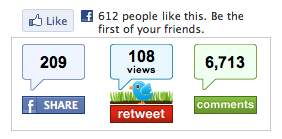You are here: Foswiki>Dmi Web>WebCurrencies2 (27 May 2014, AnneHelmond)Edit Attach
Web Currencies 2
Followup on Web Currencies. Paper citation: Gerlitz, Carolin, and Anne Helmond. 2013. The Like Economy: Social Buttons and the Data-Intensive Web. New Media & Society 15 (8): 134865. doi:10.1177/1461444812472322. http://nms.sagepub.com/content/15/8/1348.abstract .Team Members
Carolin Gerlitz (Goldsmith University) and Anne Helmond (University of Amsterdam)Introduction
The dominant currency of the web is the link.Traditionally Google ranks websites based on hyperlink counts.This may be considered a Web 1.0 approach as with 2.0 there is the emergence of separate spheres (the blogosphere, the updatesphere). On top of that social media like Facebook create new spheres behind Walled Gardens. The question then becomes: Does the hyperlink remain the dominant currency within these new spheres? What type of content rises to the top in social media spheres? In 'Links and Power: The Political Economy of Linking on the Web' (2002) Jill Walker describes how search engines (specifically Google) changed the notion of hyperlinks as "mere mechanics" to the link as "a pseudo-monetary unit." When Google introduced its link analysis algorithm PageRank (1998) it inflicted a value onto links where different links have different values: some links are more important than others: "Links have become the currency of the Web. With this economic value they also have power, affecting accessibility and knowledge on the Web." (Walker, 2002) To what extent does the notion of the link as the currency of the web still hold in Web 2.0?Claim: ReTweets Are The New Currency Of The Web by Michael Arrington, Techcrunch 2009. Has Web 2.0 and/or the Social Web introduced new social currencies such as the Like, the Share and the (re)Tweet?

Method
- Query BP Oil Spill in Google Web, Google Blogs and Google News.
- Take top 100 results for each sphere
- Collect number of Diggs, Delicious, Tweets (Tweetmeme/Topsy), FB Likes, FB Comments, FB Shares, FB Total, FB Clicks $ Tools http://tools.issuecrawler.net/beta/digg/ & Facebook measures (send spreadsheets to Erik):
- Check all numbers (see volatility of tools) and manually correct the incorrect numbers using the available Facebook Developer tools. Limitation: Like and Share are now the same (see Like & Share). In Google Blogs an unknown number of URLs caused the tools to return incorrect numbers. Manually redid the all the URLs, putting them in 1 by 1 in the following tools: http://tools.issuecrawler.net/beta/digg/ (Digg, Delicious, Tweetmeme, Topsy) http://www.facebook.com/share/ (Facebook Share) http://developers.facebook.com/docs/reference/plugins/like (Facebook Like)
- Removed Tweetmeme, decided on Topsy.
- Manually check for Like Button, Share Button and Tweet Button.
- Categorize.
Volatility of tools and methods
On merging Share & Like ( deprecation of the Share): "Share is still an option, however we merged the external count so that the count represents total interactions with the URL." The Next Web.References
Brin, S. and Page, L., "The Anatomy of a Large-Scale Hypertextual Web Search Engine". In Proceedings of 7th Int. World Wide Web Conference, (1998). < http://www7.scu.edu.au/programme/fullpapers/1921/com1921.htm > Walker, Jill. Links and Power: The Political Economy of Linking on the Web, 2002 < http://jilltxt.net/txt/linksandpower.html>| I | Attachment | Action | Size | Date | Who | Comment |
|---|---|---|---|---|---|---|
| |
socialcurrencies1.png | manage | 25 K | 21 Sep 2010 - 18:53 | AnneHelmond |
Edit | Attach | Print version | History: r6 < r5 < r4 < r3 | Backlinks | View wiki text | Edit wiki text | More topic actions
Topic revision: r6 - 27 May 2014, AnneHelmond
 Copyright © by the contributing authors. All material on this collaboration platform is the property of the contributing authors.
Copyright © by the contributing authors. All material on this collaboration platform is the property of the contributing authors. Ideas, requests, problems regarding Foswiki? Send feedback


